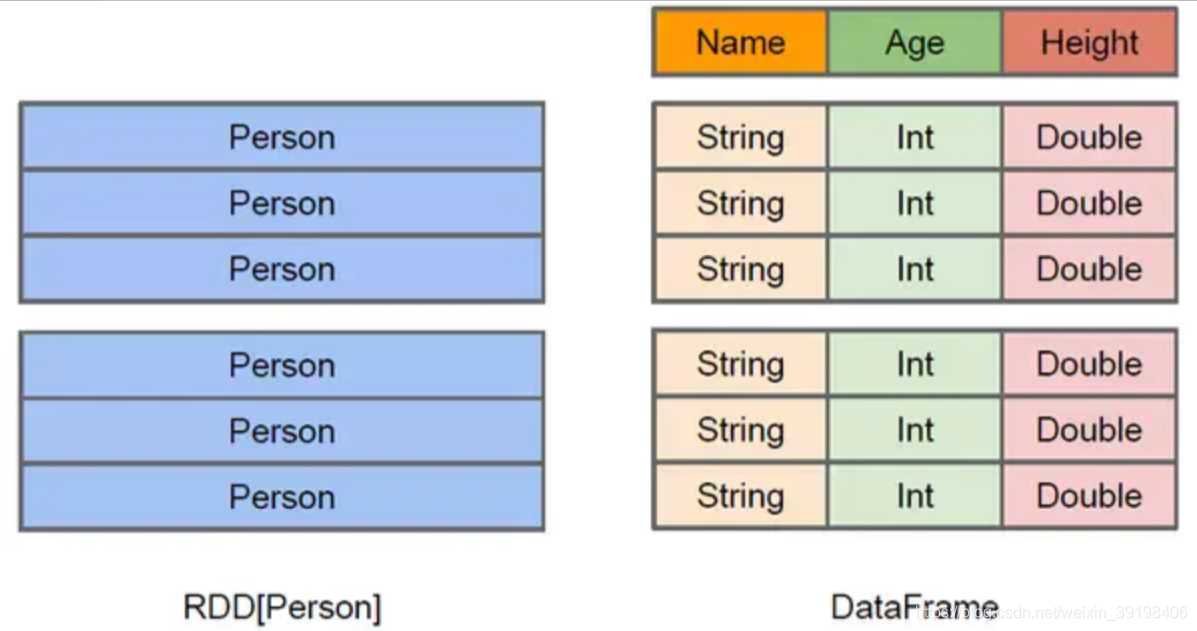您好,登錄后才能下訂單哦!
您好,登錄后才能下訂單哦!
如何在pyspark中創建DataFrame?很多新手對此不是很清楚,為了幫助大家解決這個難題,下面小編將為大家詳細講解,有這方面需求的人可以來學習下,希望你能有所收獲。
為了便于操作,使用pyspark時我們通常將數據轉為DataFrame的形式來完成清洗和分析動作。
在上一篇pyspark基本操作有提到RDD也是spark中的操作的分布式數據對象。
這里簡單看一下RDD和DataFrame的類型。
print(type(rdd)) # <class 'pyspark.rdd.RDD'> print(type(df)) # <class 'pyspark.sql.dataframe.DataFrame'>
翻閱了一下源碼的定義,可以看到他們之間并沒有繼承關系。
class RDD(object): """ A Resilient Distributed Dataset (RDD), the basic abstraction in Spark. Represents an immutable, partitioned collection of elements that can be operated on in parallel. """
class DataFrame(object): """A distributed collection of data grouped into named columns. A :class:`DataFrame` is equivalent to a relational table in Spark SQL, and can be created using various functions in :class:`SparkSession`:: ... """
RDD是一種彈性分布式數據集,Spark中的基本抽象。表示一種不可變的、分區儲存的集合,可以進行并行操作。
DataFrame是一種以列對數據進行分組表達的分布式集合, DataFrame等同于Spark SQL中的關系表。相同點是,他們都是為了支持分布式計算而設計。
但是RDD只是元素的集合,但是DataFrame以列進行分組,類似于MySQL的表或pandas中的DataFrame。

實際工作中,我們用的更多的還是DataFrame。
嘗試第一種情形發現,僅僅傳入二元組,結果是沒有列名稱的。
于是我們嘗試第二種,同時傳入二元組和列名稱。
a = [('Alice', 1)]
output = spark.createDataFrame(a).collect()
print(output)
# [Row(_1='Alice', _2=1)]
output = spark.createDataFrame(a, ['name', 'age']).collect()
print(output)
# [Row(name='Alice', age=1)]這里collect()是按行展示數據表,也可以使用show()對數據表進行展示。
spark.createDataFrame(a).show() # +-----+---+ # | _1| _2| # +-----+---+ # |Alice| 1| # +-----+---+ spark.createDataFrame(a, ['name', 'age']).show() # +-----+---+ # | name|age| # +-----+---+ # |Alice| 1| # +-----+---+
d = [{'name': 'Alice', 'age': 1}]
output = spark.createDataFrame(d).collect()
print(output)
# [Row(age=1, name='Alice')]a = [('Alice', 1)]
rdd = sc.parallelize(a)
output = spark.createDataFrame(rdd).collect()
print(output)
output = spark.createDataFrame(rdd, ["name", "age"]).collect()
print(output)
# [Row(_1='Alice', _2=1)]
# [Row(name='Alice', age=1)]from pyspark.sql import Row
a = [('Alice', 1)]
rdd = sc.parallelize(a)
Person = Row("name", "age")
person = rdd.map(lambda r: Person(*r))
output = spark.createDataFrame(person).collect()
print(output)
# [Row(name='Alice', age=1)]from pyspark.sql.types import *
a = [('Alice', 1)]
rdd = sc.parallelize(a)
schema = StructType(
[
StructField("name", StringType(), True),
StructField("age", IntegerType(), True)
]
)
output = spark.createDataFrame(rdd, schema).collect()
print(output)
# [Row(name='Alice', age=1)]df.toPandas()可以把pyspark DataFrame轉換為pandas DataFrame。
df = spark.createDataFrame(rdd, ['name', 'age']) print(df) # DataFrame[name: string, age: bigint] print(type(df.toPandas())) # <class 'pandas.core.frame.DataFrame'> # 傳入pandas DataFrame output = spark.createDataFrame(df.toPandas()).collect() print(output) # [Row(name='Alice', age=1)]
output = spark.range(1, 7, 2).collect() print(output) # [Row(id=1), Row(id=3), Row(id=5)] output = spark.range(3).collect() print(output) # [Row(id=0), Row(id=1), Row(id=2)]
通過臨時表得到DataFrame
spark.registerDataFrameAsTable(df, "table1")
df2 = spark.table("table1")
b = df.collect() == df2.collect()
print(b)
# True在createDataFrame中可以指定列類型,只保留滿足數據類型的列,如果沒有滿足的列,會拋出錯誤。
a = [('Alice', 1)]
rdd = sc.parallelize(a)
# 指定類型于預期數據對應時,正常創建
output = spark.createDataFrame(rdd, "a: string, b: int").collect()
print(output) # [Row(a='Alice', b=1)]
rdd = rdd.map(lambda row: row[1])
print(rdd) # PythonRDD[7] at RDD at PythonRDD.scala:53
# 只有int類型對應上,過濾掉其他列。
output = spark.createDataFrame(rdd, "int").collect()
print(output) # [Row(value=1)]
# 沒有列能對應上,會拋出錯誤。
output = spark.createDataFrame(rdd, "boolean").collect()
# TypeError: field value: BooleanType can not accept object 1 in type <class 'int'>spark.registerDataFrameAsTable(df, "table1")
spark.dropTempTable("table1")print(spark.getConf("spark.sql.shuffle.partitions")) # 200
print(spark.getConf("spark.sql.shuffle.partitions", u"10")) # 10
print(spark.setConf("spark.sql.shuffle.partitions", u"50")) # None
print(spark.getConf("spark.sql.shuffle.partitions", u"10")) # 50spark.registerFunction("stringLengthString", lambda x: len(x))
output = spark.sql("SELECT stringLengthString('test')").collect()
print(output)
# [Row(stringLengthString(test)='4')]
spark.registerFunction("stringLengthString", lambda x: len(x), IntegerType())
output = spark.sql("SELECT stringLengthString('test')").collect()
print(output)
# [Row(stringLengthString(test)=4)]
spark.udf.register("stringLengthInt", lambda x: len(x), IntegerType())
output = spark.sql("SELECT stringLengthInt('test')").collect()
print(output)
# [Row(stringLengthInt(test)=4)]可以查看所有臨時表名稱和對象。
spark.registerDataFrameAsTable(df, "table1")
print(spark.tableNames()) # ['table1']
print(spark.tables()) # DataFrame[database: string, tableName: string, isTemporary: boolean]
print("table1" in spark.tableNames()) # True
print("table1" in spark.tableNames("default")) # True
spark.registerDataFrameAsTable(df, "table1")
df2 = spark.tables()
df2.filter("tableName = 'table1'").first()
print(df2) # DataFrame[database: string, tableName: string, isTemporary: boolean]前提是需要下載jar包。
Mysql-connector-java.jar
from pyspark import SparkContext
from pyspark.sql import SQLContext
import pyspark.sql.functions as F
sc = SparkContext("local", appName="mysqltest")
sqlContext = SQLContext(sc)
df = sqlContext.read.format("jdbc").options(
url="jdbc:mysql://localhost:3306/mydata?user=root&password=mysql&"
"useUnicode=true&characterEncoding=utf-8&useJDBCCompliantTimezoneShift=true&"
"useLegacyDatetimeCode=false&serverTimezone=UTC ", dbtable="detail_data").load()
df.show(n=5)
sc.stop()看完上述內容是否對您有幫助呢?如果還想對相關知識有進一步的了解或閱讀更多相關文章,請關注億速云行業資訊頻道,感謝您對億速云的支持。
免責聲明:本站發布的內容(圖片、視頻和文字)以原創、轉載和分享為主,文章觀點不代表本網站立場,如果涉及侵權請聯系站長郵箱:is@yisu.com進行舉報,并提供相關證據,一經查實,將立刻刪除涉嫌侵權內容。